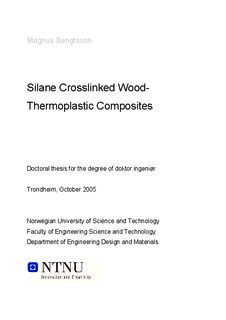| dc.contributor.author | Bengtsson, Magnus | nb_NO |
| dc.date.accessioned | 2014-12-19T11:25:00Z | |
| dc.date.available | 2014-12-19T11:25:00Z | |
| dc.date.created | 2006-01-27 | nb_NO |
| dc.date.issued | 2005 | nb_NO |
| dc.identifier | 125813 | nb_NO |
| dc.identifier.isbn | 82-471-7297-6 | nb_NO |
| dc.identifier.uri | http://hdl.handle.net/11250/231284 | |
| dc.description.abstract | Wood-thermoplastic composites are a more environmental friendly alternative for pressure-treated lumber but can also replace engineering plastic products. These composites have been on the market for more than ten years now and have mainly been used in building and automotive applications. The use of these materials has shown that long-term properties, durability, and toughness are the main problems. The aim of this study was to investigate if silane crosslinking could be one way of solving these problems. Silane crosslinked woodthermoplastic composites with polyethylene as the matrix and wood flour as reinforcement were manufactured by melt compounding. A reactive extrusion process was developed where compounding of polyethylene and wood flour and silane grafting were carried out simultaneously. The extrusion process was optimized and used in larger scale profiling of crosslinked composites. The composite materials were evaluated using chemical analysis, mechanical testing, spectroscopic analysis, thermal analysis, and electron microscopy. The crosslinking reaction was shown to be initiated during compounding of the composites and was significantly increased upon storage in a high humidity sauna at elevated temperature. The crosslinked composites showed toughness, impact strength and creep properties superior to the non-crosslinked composites. Scanning electron microscopy on the fracture surface of the crosslinked composites revealed good interfacial adhesion between the wood fibres and the polyethylene matrix. Based on results from this study, it is proposed that silane crosslinking creates a three dimensional network in the polyethylene matrix with chemical bonding to the wood fibres.
Future evaluation of results from accelerated weathering studies will reveal if silane crosslinking can improve the durability of wood-thermoplastic composites during outdoor exposure. Investigation of the potential of silane crosslinking on other type of composite systems with other thermoplastic matrices and natural fibres would also be of interest. | nb_NO |
| dc.language | eng | nb_NO |
| dc.publisher | Fakultet for ingeniørvitenskap og teknologi | nb_NO |
| dc.relation.ispartofseries | Doktoravhandlinger ved NTNU, 1503-8181; 2005:201 | nb_NO |
| dc.relation.haspart | Bengtsson, M; Gatenholm, P; Oksman, K. The effect of crosslinking on the properties of polyethylene/wood flour composites. Composite Science and Technology. 65(10): 1468-1479, 2005. | nb_NO |
| dc.title | Silane Crosslinked Wood-Thermoplastic Composites | nb_NO |
| dc.type | Doctoral thesis | nb_NO |
| dc.contributor.department | Norges teknisk-naturvitenskapelige universitet, Fakultet for ingeniørvitenskap og teknologi | nb_NO |
| dc.description.degree | dr.ing. | nb_NO |
| dc.description.degree | dr.ing. | en_GB |
